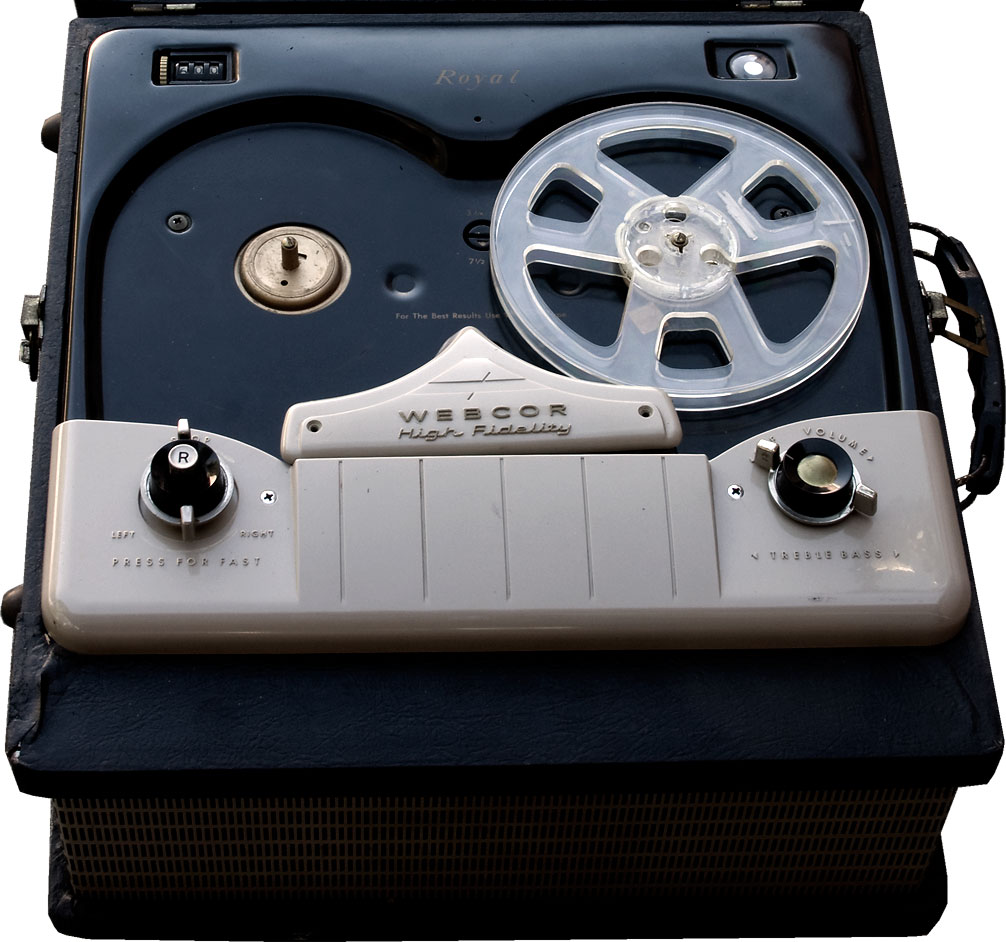
Early Webcor tape recorders just had model numbers, but in the late 50s they began giving them names. In 1957/58, when this machine was new, the top-end deluxe stereo model was the Imperial, the monoaural Royal Coronet was next, and my Royal was a half-step down from that.
The difference between the Royal and Royal Coronet (models 2611 and 2612 respectively) is entirely due to the speakers. The Royal had one 9Ω speaker; the Royal Coronet had three 3.2Ω speakers. The Coronet's cabinet was a little larger to accomodate it, and it weighed in at 49 lbs, whereas my Royal is only 42 lbs. Otherwise they're identical. Check out the SAMS Photofact (S35 328, Folder 13) if you don't believe me.
The dash number suffix is for the cabinet color and input supply voltage. -1 was black (Ebony) at 110V, -2 was tan at 110V. -3 and -4 are the same but run off 220V.
So a long story shortened: I grew up in the era of 8-track tapes and cassettes, and like a lot of kids I started recording stuff off the radio, the tv (this was before VCRs), playing disc-jockey and the like. Finally The Old Man let me use his Wollensak reel recorder (see below). Reel recorders from the late 50s didn't have the dynamic audio range of even crappy 70s cassette recorders, but they were still a lot better in all sorts of ways.
Maybe a year later I bought a Webcor 210 at a yard sale for $5, a 50lb luggable beast. The Old Man recapped it and got it going. It was huge, a back-breaker, it was ½-track mono, with the audio frequency range of a 60-year-old man. But it was mine and I loved it.
.jpg) After that a few more passed in and out of our possession; somehow mine disappeared or was wrecked. When I stumbled across this Royal, also for $5, I grabbed it. It needs some TLC but it is still fundamentally sound. I doubt any of the people who built this machine honestly thought it would still be playing in the 21st century.
After that a few more passed in and out of our possession; somehow mine disappeared or was wrecked. When I stumbled across this Royal, also for $5, I grabbed it. It needs some TLC but it is still fundamentally sound. I doubt any of the people who built this machine honestly thought it would still be playing in the 21st century.
I also bought it because it's the only machine I have that can handle ½-track recordings. ½-track is an early monoaural format where you split the tape lengthwise in half and record one track in each direction. When stereo came out they went to a 4-track system, two (left and right) in each direction. For mono systems, they simply laid both tracks with the same information and called it 2-track mono.
Things would have been backward compatible if the two tracks (going in the same direction) were placed side-by-side, but noooo, they alternated them instead. So a ½-track machine can only play ½-track recordings; if you play a 2 or 4-track recording, it picks up one track going the proper direction and one track going backward, and plays them simultaneously.
4-track machines (and their 2-track mono versions) can theoretically play ½-track recordings by simply muting one channel or the other. In reality it never seems to work—either the machine doesn't have separate channel volume controls or the balance doesn't completely cut one channel, and there's also some kind of bleed-through. My opinion is if you want to play ½-track recordings, use a ½-track machine.
